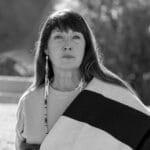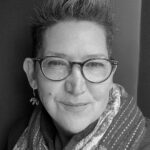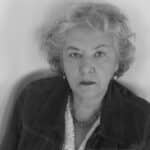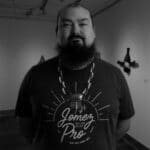Spring 2024 IAIA Artist-in-Residence Program
For Spring 2024, the Institute of American Indian Arts (IAIA) will host an exciting lineup of five established and rising Native artists in our Artist-in-Residence (A-i-R) Program. IAIA Professor Emerita and Honorary Doctorate Charlene Teters (Spokane) ’86 will join us from January 29–February 29, Holly Wilson (Delaware Nation, Lenape) A-i-R ’22 will join us from January 22–February 22, Tamara Ann Burgh (Swede and Inupiaq-Kawerak) A-i-R ’21 will join us from March 4–April 12, Brian Walker II (Inupiat and Deg Hit’an) ’20 will have a hybrid residency in-person from March 4–22 and virtually from March 23–April 12, and Jerry Brown (Diné) ’95 and Golga Oscar (Yup’ik) ’20 will join us from April 15–May 10.
Meet these impressive artists at A-i-R welcome dinners and open studios throughout the semester, which are free and open to the public!
Artist-in-Residence Events
- Monday, February 5, 5–7 pm (MST): Teters and Wilson Welcome Dinner and Open Studios—Academic Building, IAIA Campus
- Tuesday, February 13, 3–5 pm (MST): Teters and Wilson Open Studios—Academic Building, IAIA Campus
- Tuesday, March 5, 5–7 pm (MST): Burgh and Walker Welcome Dinner and Open Studios—Academic Building, IAIA Campus
- Tuesday, March 19, 3–5 pm (MDT): Burgh and Walker Open Studios—Academic Building, IAIA Campus
- Monday, April 22, 5–7 pm (MDT): Brown and Oscar Welcome Dinner and Open Studios—Academic Building, IAIA Campus
- Tuesday, May 7, 3–5 pm (MDT): Brown and Oscar Open Studio—Academic Building, IAIA Campus
For more information about the A-i-R Program, contact Angelica Gallegos, Interim A-i-R Manager and Museum Studies Visiting Faculty, at agallegos@iaia.edu or (505) 424-2369.
If you are an individual with a disability in need of any type of auxiliary aid or service to attend events, please contact IAIA’s ADA Office at least seven calendar days before the event or as soon as possible at adaoffice@iaia.edu or (505) 424-5707.
Bios

Charlene Teters
Charlene Teters
January 29–February 29, 2024
Professor Emerita Charlene Teters (Spokane) earned an AFA in 1986 from IAIA, a BFA from the College of Santa Fe in 1988, and an MFA from the University of Illinois Urbana-Champaign in 1994. In 2000, she was awarded an honorary Doctorate of Fine Arts from Mitchell College in New London, CT, and an honorary Doctorate of Humanities from the Institute of American Indian Arts in 2021.
As an integral part of her established art practice, Professor Teters is also known for her transformative activism on issues ranging from eliminating derogatory sports mascots to raising awareness of Missing and Murdered Indigenous Women.

Holly Wilson
Holly Wilson
January 22–February 22, 2024
Multi-media artist Holly Wilson (Delaware Nation, Lenape, and Descendent of the Delaware Tribe of Indians) creates figures as her storytellers, conveying stories of the sacred and the precious, capturing moments of our day, vulnerabilities, and strengths. The stories are, at one time, both representations of family history and personal experiences. Wilson’s work reaches a broad audience, allowing the viewer to see their own personal connection. She works in various media, including bronze, paint, encaustic, photography, and clay.

Tamara Ann Burgh
Tamara Ann Burgh
March 4–April 12, 2024
Moving alternately between Colorado and Illinois as a child, Tamara Ann Burgh (Swede and Inupiaq-Kawerak) A-i-R ’21 jokes she was raised on Interstate 80. As an adult, she has lived and worked in Alaska, Australia, Wisconsin, and Chicago, establishing careers in graphic arts, product design, contract sculpting, and publishing.
For some twelve years, she put her career on hold to care for her dementia-inflicted mother. After her mother passed in 2016, Tamara prioritized her creativity to that of a fine artist and relocated her home and studio from Arkansas to Santa Fe, New Mexico.
Tamara has always been an avid student of religion, spiritual symbolism, mysticism, and classical and Native American myth. Through her metaphysical studies, she has established a library of books by authors such as Clarissa Pinkola Estes, Joseph Campbell, Jidda Krishnamurti, Carolyn Myss, David R. Hawkins, Abraham Hicks, and many more.
For most of her life, Tamara lived and worked in Caucasian suburbia while her Native heritage remained in the background. Her art now focuses on what her Nativeness means to her, specifically how to image her experiences and beliefs as a mixed-race woman whose cultural heritages are radically different. Her work is typically an autobiographical symbolic reinterpretation of her experiences and cultural and spiritual beliefs.
Tamara’s creative work is a spiritual process inspired by archetypes, myth, scripture, universal ideas, and her carefully considered symbols. Her concepts inform the medium, and most of her highly detailed and complex work takes years to complete. Burgh states, “I choose to make art that is aesthetically complex and presents an element of the sacred. I hope to make works of art viewers can’t help but explore when they walk into the room.”

Brian Walker II
Brian Walker II
March 4–April 12, 2024 (Hybrid Residency) | In-person: March 4–22, 2024 | Virtual: March 23–April 12, 2024
Brian Walker II (he/him) ’20 is an Inupiat and Deg Hit’an mask carver from Anchorage, Alaska. He apprenticed with Alaskan Native Master Artists Perry Eaton and Alvin Amason. Growing up, living off the land, and being taught cultural traditions, Brian uses his identity and background to express Indigenous narratives. He attains his inspiration from invaluable life experiences and everyday encounters with the animals and people of Alaska.
Brian works at Cook Inlet Tribal Council’s Fab Lab as an educator, and his focus is to help model Indigenous identity work with Indigenous youth. He designs and instructs Indigenous Science, Technology, Engineering, Arts, and Math (STEAM) curriculum for students.

Golga Oscar
Golga Oscar
April 15–May 10
Golga Oscar (Yup’ik) ’20 is an artist from Southwest Alaska. Oscar is an artist who pursues modern textiles that reflect his cultural identity. Within his practice, he seeks not only to revitalize ancestral art forms but also to include and incorporate contemporary material and design.
Oscar works with and explores mediums ranging from leather and skin sewing to grass weaving, walrus ivory, and wood carving. A strong cultural identity is evident in his work. Through his knowledge of traditional art forms and his sewing skills, he creates cultural attire, a vital visual element in his photographic imagery. Oscar’s work has been collected by several museums, which include the Anchorage Museum, the Burke Museum, and the Museum of International Folk Art.
Oscar’s images of Indigenous people exhibit the importance of Native heritage and the validity of their existence. Through his work and traditional knowledge systems, he strives to Indigenize spaces in Western environments.

Jerry Brown
Jerry Brown
April 15–May 10
Jerry Brown (Diné) ’95 is a 1995 graduate of the Institute of American Indian Art. Brown has always viewed the world through the lens of abstraction, and his time at IAIA opened a whole new world for him. Brown says it freed him to explore and create what he wanted, not what others expected.
Brown is committed to keeping his home base in Mariano Lake, New Mexico. He says his land is where he draws his energy and creativity from. This is where the emotion, color, movement, and gestures in his work come through him. When Brown paints, he feels like he is releasing the turmoil of a tough childhood, his traditional spirituality, and his love of nature on paper and canvas. Brown loves to create abstract works. The abstraction allows him to paint that space between his traditions and himself, “the place of family, laughter, ceremony.” Brown says that as he creates a piece, it takes on a life of its own. Daily life seeps into his work, and his life is in the many layers he puts down on the canvases.
Brown has always viewed art as a means of expression, speaking his message to the viewer. Artists have always created work that speaks to social justice issues. Like those before him, Brown strives to use his art to raise awareness about social justice issues and attempts to start a conversation that could bring positive change.